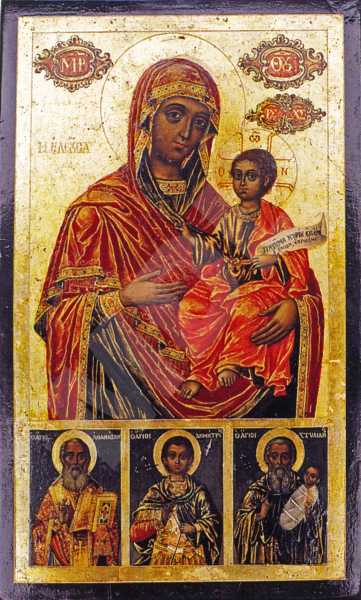The Virgin Eleussa with Saint Athanasius, Saint Dimiter and Saint Stylian
Type:
Icon
Period:
From
the beginning of the
19 century
to
the end of the
19 century
Dimiter T. Molerov, born in 1780 in Bansko, son of Toma Vishanov the Moler. One of the best-known painters, a representative of the Bansko school of art, a disciple of his father, influenced by the art of Athos. Author of the murals of the naos in the St Archangels' paraclete in the Rila monastery, the murals in the Church of the Assumption of the Virgin in the Pchelino dependance. In 1840 and 1841 together with his son Simeon Molerov he paints the murals and the sponsors' portraits in St. Nicholas' and St. John of Rila's paracletes in the principal church in the Rila monastery. Among D. Molerov's major achievements in iconography are the following icons: St. Nicholas (1816) from St. Archangel Michael's church in the village of Leshko, Christ All-triumphant with Angels and Cherubim (1833), The Nativity and a Crucifixion from St Elijah the Prophet's church in the village of Usenovo. He has also worked in Belgrade on an invitation by Prince Milosh Obrenovich of Serbia. He died in 1870 in Bansko.
Dimmensions (cm):
32
/ 20.5
/ 3.5
Location
Country: Bulgaria
Private collection: Private collection
Source
Country: Bulgaria
Other source: Others
Description
A not very traditional iconographic composition painted in which, in addition to the Holy Mother of God with the Infant, are in the icon's lower belt also three saints: Saint Athanasius, Saint Dimiter and Saint Stylian. The gilding, the skillful graphic line-up and the colouring suggest the hand of an experienced master-painter.
Iconographical technique: Combined
With velaturas and "probaster". The "wet into wet" method has been used in the carnations. The varnish cover is applied thinly and evenly. The gilding on the aureoles and on the background is with gold-leaf. There is some engraving on the saint's aureole.
Base material: Wood
The icon's base is a one-piece softwood panel, well smoothed on both sides. The ground coat is of a thinly laid layer of plaster.
State, restoration traces and comments
There are no traces of any previous restorative intervention.


